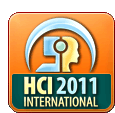T05: Cost-effective User-Centered Design based on ISO 9241-210
Half Day Tutotial
Nigel Bevan (short bio)
Professional Usability Services, United Kingdom
Objective
Participants will learn a structured approach to user-centered design that implements the requirements in the international standard "Human centered design for interactive systems" (ISO 9241-210) and other associated standards. They will gain practical experience of the key methods needed to implement user-centered design. By the end of the tutorial they will have sufficient knowledge to know how to choose a limited number of appropriate methods when resources are restricted.
Content and Benefits
The tutorial will explain the basis for choosing appropriate usability methods and techniques, and give an overview of selected methods. The principles will be illustrated with experience from a case study and short group exercises to familiarize participants with the key methods. The methods have been validated by practical application in industry. The tutorial will focus on core set of techniques to support the human-centered design process advocated by ISO 9241-210. The techniques have been selected based on their applicability, maturity, availability, and cost-effectiveness, and have been used in a wide range of organizations. The techniques are broadly divided into three categories: planning, early lifecycle, and late lifecycle, and include: a stakeholder meeting, identifying the context of use, producing scenarios of use, evaluating an existing system, specifying usability requirements, prototyping, using style guides, usability testing and collecting feedback. For each potential method, the tutorial provides information that includes when the method should be used, the type of results provided, the number of usability experts and users required, and the typical range of person days involved. Selection of methods should take account of these factors in meeting the business priorities for usability. The tutorial notes will be supplemented by reference material and cross-references to a web site of resources. The tutorial has received high ratings at previous conferences.
Target audience
Beginners, with little or no previous experience of user centered design.
Relevant links
Bio Sketch of Presenter:


